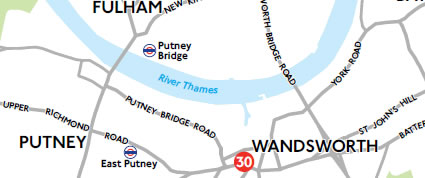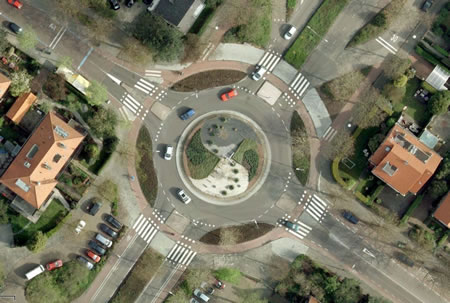“Sixties Relics” To Be Ripped Out
33 road junctions to be made safer as cycle transformation begins
Thirty-three of London’s biggest and nastiest road junctions will be transformed in a £300 million programme to make them safer and less threatening for cyclists and pedestrians, the Mayor and TfL announced today.
The gyratory at Wandsworth, among others, will be ripped out and replaced with two-way roads, segregated cycle tracks and new traffic-free public space. As part of the wider development plans for the area (specifically associated with the Ram Brewery site), TfL is working with the Council to develop a new road layout which would decrease traffic dominance in the high street and help rejuvenate the town centre.
Richard Tracey Assembly Member for Wandsworth & Merton told PutneySW15.com: "This is very welcome news for Wandsworth from Boris Johnson. And something we have been calling for over some time. It should make a difference."
The Elephant & Castle roundabout, London’s highest cycle casualty location, will be removed. At other intimidating gyratories, such as Hammersmith and Vauxhall, safe and direct segregated cycle tracks will be installed, pending more radical transformations of these areas in the medium term.
Detailed designs for the first schemes will be published next month and work will begin in the second half of this year.

The Mayor of London, Boris Johnson, said: “These road junctions are relics of the Sixties which blight and menace whole neighbourhoods. Like so much from that era, they’re also atrociously-designed and wasteful of space. Because of that, we can turn these junctions into more civilised places for cyclists and pedestrians, while at the same time maintaining their traffic function.”
The junction programme has been fundamentally refocused away from making minor, often cosmetic changes at a large number of junctions to delivering real and transformational change at the busiest and worst junctions.
The pre-Cycling Vision programme would have divided £19 million between 100 junctions, an average of £190,000 per junction. The new programme commits in the region of £300 million to just 33 major junctions, an average of £9 million per junction.
The money will come from the £100 million Better Junctions budget announced in the Cycling Vision, from the Vision’s Cycle Superhighways budget for those on superhighways, from the general TfL Major Schemes programme budget and from confirmed third-party and developer contributions in the order of £50 million. Most junctions will use a mixture of some or all of these funding streams.
Most serious bike and pedestrian injuries and fatalities occur at junctions. In the last three years, more than 150 cyclists and pedestrians have been killed or seriously injured at these 33 locations. Yet many are unavoidable, without side-street alternatives.
There will also be improvements to many junctions not on the list of 33 published today, usually delivered and funded as part of specific new or upgraded cycle routes. For instance, only one of the junctions on Cycle Superhighway 2 – Bow Roundabout is on the list. But, as we have already announced, five other junctions on the route will be improved as part of its upgrade, with fully cycle-segregated approaches and cycle-specific traffic lights to reduce conflict with turning traffic.
Similar improvements will take place on our other new and upgraded Cycle Superhighway routes. On the Quietway network of back-street cycle routes, places where the Quietways cross main roads, or use them for short stretches, will be improved. The Dutch-style roundabout (pictured below), with segregated lanes, tested at the Transport Research Laboratory last year will be implemented at a trial location in Greater London in early 2015. The general TfL roads programme also includes a number of further junction schemes to benefit pedestrians and cyclists.

Leon Daniels, Managing Director of Surface Transport at TfL, said: “For over a year our designers and engineers have been working flat out to develop new junction designs for these 33 locations to completely change how they operate, transforming their areas for cyclists, pedestrians and the wider local community. They are some of the busiest traffic intersections in Europe, so this work has been complicated. But we are now fully committed to delivering these junction improvements as quickly as possible, making London safer and more inviting for all.”
February 27, 2014